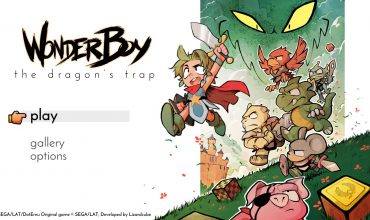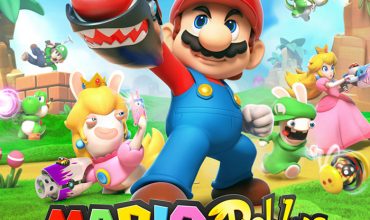Trust the Fun, Gus!
On May 28th of this year, the infamous Super Mario Bros. movie celebrated its 25th anniversary, to very little fanfare. At the time of its release, it was harshly panned by critics and fans of the games, and practically disavowed by both the studio that produced it — the now-defunct Hollywood Pictures (a division of the Walt Disney Company) — and Nintendo, who officially licensed and helped promote it. Since then, it had an obligatory VHS release, a bare-bones and non-anamorphic DVD release, and a Blu-ray released exclusively in Europe (by an independent British distributor, Second Sight Films — info source: Blu-ray.com).

Official Release Poster — source: Google Image search
If you want a story of its production, and all the problems that plagued it, there are countless articles and YouTube videos documenting it, so I won’t be getting into it here (I highly recommend Super Mario Bros. The Movie Archive, and Norman Caruso’s documentary on The Gaming Historian channel), suffice to say it involved endless amounts of executive meddling, tonal shifts, on-set re-writes, amateur directors, and drunk actors. Everyone who was in it hated it. The directors who made it saw an abrupt end to their brief career. The film lost a lot of money, and provided the genesis for a quarter-century of game-to-film adaptations that have ranged in quality from atrocious to mediocre to not altogether awful.
But how bad is Super Mario Bros., really?
Let’s try to look at it objectively.
The film opens with an animated introduction to the backstory. Basically, when the meteor struck Earth 65 million years ago, it didn’t destroy the dinosaurs, it banished them to an alternate dimension where they evolved into humanoid forms side-by-side with mammals. They have a society and technology, utilities and vehicles, and everything else we had in our modern urban culture circa 1993. At some point in its history, Koopa usurped the throne from the Dinosaur Kingdom’s peaceful king, and began a destructive and resource-draining campaign to merge the realms and conquer the mammalian species. In the opening (non-animated) narrative scene, a young woman drops a basket at a convent in New York City, in which the nuns find an egg, whence a baby girl hatches, and a mysterious rock on a string.
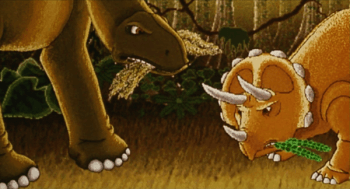
Animated prologue — image source: Super Mario Bros. The Movie Archive
Meanwhile, on the human side, Mario and Luigi are struggling plumbers in Brooklyn, NY. They are in competition with a conglomerate company run by the unscrupulous Scapelli family. Nearby, a young paleontology student named Daisy, who wears a very familiar rock around her neck, has a run-in with the Scapellis, who sabotage the dig site by trying to flood it. While the Mario Brothers fix the leak, Daisy is kidnapped, and Mario and Luigi are forced to rescue her. They find a portal to another realm in a rock wall below the sewer, and follow her through to the Koopa-run city of Dinohattan.
So at this point, those of you who are ignorant to the movie’s… um, “creative liberties” are probably baffled. The plot almost seems as though it was written for a completely different movie with the names of the Super Mario characters hastily pasted into the final draft of the script, and the next 80 minutes or so does little to disprove this hypothesis. Along our heroes’ journey, we will encounter a street musician named Toad, a pair of henchmen named Iggy and Spike, a bouncer named Big Bertha who works at a nightclub known as the Boom Boom Bar, an infant Tyrannosaurus called Yoshi, rocket boots called Thwomp-Stompers are powered by Bullet Bill-shaped cartridges, and several large-bodied, tiny-headed, intellectually-deficient reptilian grunts referred to as Goombas.
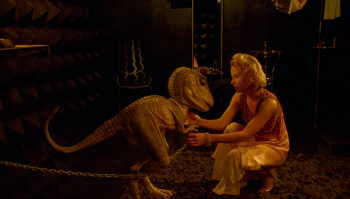
Yoshi (left) and Daisy (right) — image source: Nintendo Player
Divorcing the product from its source material reveals its brilliant pedigree, however. The sets were designed by legendary artist David L. Snyder, best known for Blade Runner, from which he clearly drew more than a little inspiration. The highly-detailed and futuristic-yet-low-tech set dressings of Dinohattan create a perfect dystopian mise-en-scène. The animatronic puppetry of Yoshi and the Goombas are as convincing as any Jim Henson production. CGI, still in its infancy (this film released almost side-by-side with Jurassic Park), is thankfully used sparingly, and mostly to enhance the pre-existing practical effects.
The plot progression follows a pretty basic MacGuffin structure, not dissimilar from Raiders of the Lost Ark, really. Most of the film is spent looking for, trying to acquire, or losing the stone. There are some cat-and-mouse chase scenes, some hot potato, some bait-and-switch — all the typical-but-effective tropes of the genre. There’s a Chekov’s Gun moment that doesn’t amount to much because of time and budgetary cuts, but all around, it’s actually a pretty average family adventure movie with a dystopian sci-fi twist.
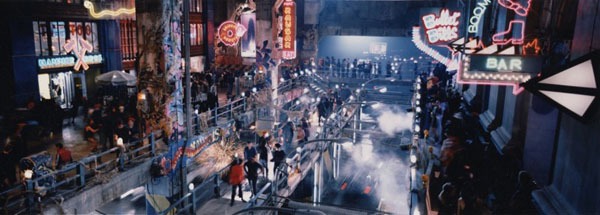
Dinohattan — image source: MarioWiki
Where it fails miserably is in its treatment of the source material. Luigi is Mario’s adopted son/younger brother, instead of his twin and blood relative. The damsel in need of rescue is Daisy, not Peach (or Toadstool, as she was known in English at the time — which, honestly, is probably why they didn’t go with the name). Koopa (not Bowser) is president, not King, and he is, like everyone else, humanoid. The kingdom is inhabited by dinosaurs, not mushroom people — although fungal organisms do play an important role. The Goombas are, as previously described, large and reptilian, not small and chestnut-like. Toad is (at least briefly) humanoid, as are Iggy, Spike, Big Bertha, and just about every other recognizable namesake. The Brothers don’t even wear anything remotely resembling their characteristic red and green uniforms (shown on every poster) until the third act.
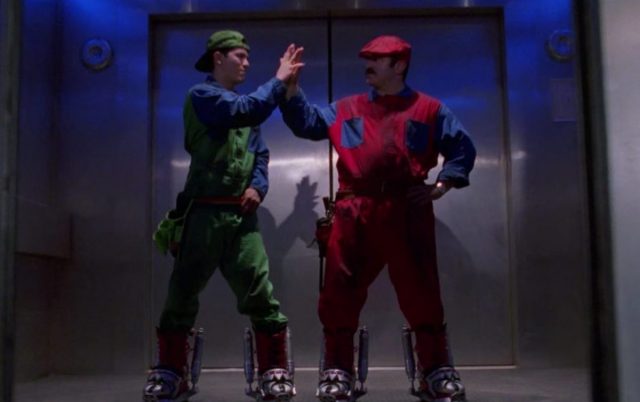
The Super Mario Brothers (finally) suit up — image source: The Mary Sue
But putting pedantry aside, the movie is somehow enjoyable through all its flaws. Maybe it was the result of intoxication, or maybe it’s just good editing, but Bob Hoskins and John Leguizamo seem to be genuinely having fun with their characters throughout (according to both, it was the former). Dennis Hopper, who retrospectively abhors this movie, fully commits to being an evil, egg-sucking son of a snake, striking a near-perfect balance of ham and restraint for a live-action cartoon villain. Now an award-winning actress, the relatively unknown Fiona Shaw gives one of the best performances in the movie as Koopa’s unappreciated right-hand woman, Lena. Fisher Stevens and Richard Edson, who play Koopa’s cousins and henchmen, Iggy and Spike, manage to be amusing as both imbeciles and intellectuals. Samantha Mathis is… cute.
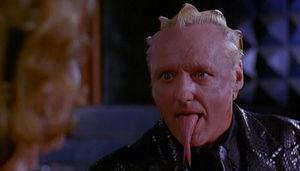
Dennis Hopper as President Koopa — image source: Villains Wiki
The action sequences have an almost Die Hard meets Looney Tunes quality, and Alan Silvestri’s bouncy score helps with the levity. Being a ’90s movie for kids, there is surprisingly little gross-out humor, which is definitely not a bad thing. Most of the humor is character-based, which actually benefits the adults in the audience more than the kids. References to the games are peppered throughout the film, but most of them won’t hit you over the head. They clearly tried to make a movie the grownups could enjoy without encyclopedic knowledge of the source.
It’s an inconsistent mess of a film that tried really hard to do a lot of things the best way possible, while totally phoning in everything else. Production was disorganized, cast and crew were understandably frustrated, and the studio had to try to sell a movie that was too mature for kids, too childish for adults, and wasn’t really about the video game it was supposed to be based on. The end result is a spectacular train wreck that manages to annoy, entertain, and confuse its target audience all at once. Is it a bad movie? Not really. Is it a good movie? Not by a long shot. Is it a must see for any fan of Nintendo who possesses a sense of irony? Most definitely.

